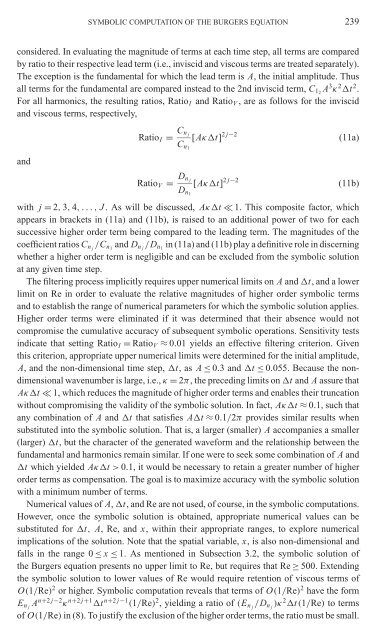A Preliminary Study of the Burgers Equation with Symbolic ...
A Preliminary Study of the Burgers Equation with Symbolic ...
A Preliminary Study of the Burgers Equation with Symbolic ...
Create successful ePaper yourself
Turn your PDF publications into a flip-book with our unique Google optimized e-Paper software.
SYMBOLIC COMPUTATION OF THE BURGERS EQUATION 239<br />
considered. In evaluating <strong>the</strong> magnitude <strong>of</strong> terms at each time step, all terms are compared<br />
by ratio to <strong>the</strong>ir respective lead term (i.e., inviscid and viscous terms are treated separately).<br />
The exception is <strong>the</strong> fundamental for which <strong>the</strong> lead term is A, <strong>the</strong> initial amplitude. Thus<br />
all terms for <strong>the</strong> fundamental are compared instead to <strong>the</strong> 2nd inviscid term, C12 A3 κ 2 t 2 .<br />
For all harmonics, <strong>the</strong> resulting ratios, RatioI and RatioV , are as follows for <strong>the</strong> inviscid<br />
and viscous terms, respectively,<br />
and<br />
RatioI = Cn j<br />
Cn1<br />
RatioV = Dn j<br />
Dn1<br />
[Aκt] 2j−2<br />
[Aκt] 2j−2<br />
(11a)<br />
(11b)<br />
<strong>with</strong> j = 2, 3, 4,...,J. As will be discussed, Aκt ≪1. This composite factor, which<br />
appears in brackets in (11a) and (11b), is raised to an additional power <strong>of</strong> two for each<br />
successive higher order term being compared to <strong>the</strong> leading term. The magnitudes <strong>of</strong> <strong>the</strong><br />
coefficient ratios Cn j /Cn1 and Dn /Dn1 in (11a) and (11b) play a definitive role in discerning<br />
j<br />
whe<strong>the</strong>r a higher order term is negligible and can be excluded from <strong>the</strong> symbolic solution<br />
at any given time step.<br />
The filtering process implicitly requires upper numerical limits on A and t, and a lower<br />
limit on Re in order to evaluate <strong>the</strong> relative magnitudes <strong>of</strong> higher order symbolic terms<br />
and to establish <strong>the</strong> range <strong>of</strong> numerical parameters for which <strong>the</strong> symbolic solution applies.<br />
Higher order terms were eliminated if it was determined that <strong>the</strong>ir absence would not<br />
compromise <strong>the</strong> cumulative accuracy <strong>of</strong> subsequent symbolic operations. Sensitivity tests<br />
indicate that setting RatioI = RatioV ≈ 0.01 yields an effective filtering criterion. Given<br />
this criterion, appropriate upper numerical limits were determined for <strong>the</strong> initial amplitude,<br />
A, and <strong>the</strong> non-dimensional time step, t, asA≤0.3and t ≤ 0.055. Because <strong>the</strong> nondimensional<br />
wavenumber is large, i.e., κ = 2π, <strong>the</strong> preceding limits on t and A assure that<br />
Aκt ≪1, which reduces <strong>the</strong> magnitude <strong>of</strong> higher order terms and enables <strong>the</strong>ir truncation<br />
<strong>with</strong>out compromising <strong>the</strong> validity <strong>of</strong> <strong>the</strong> symbolic solution. In fact, Aκt ≈0.1, such that<br />
any combination <strong>of</strong> A and t that satisfies At ≈ 0.1/2π provides similar results when<br />
substituted into <strong>the</strong> symbolic solution. That is, a larger (smaller) A accompanies a smaller<br />
(larger) t, but <strong>the</strong> character <strong>of</strong> <strong>the</strong> generated waveform and <strong>the</strong> relationship between <strong>the</strong><br />
fundamental and harmonics remain similar. If one were to seek some combination <strong>of</strong> A and<br />
t which yielded Aκt >0.1, it would be necessary to retain a greater number <strong>of</strong> higher<br />
order terms as compensation. The goal is to maximize accuracy <strong>with</strong> <strong>the</strong> symbolic solution<br />
<strong>with</strong> a minimum number <strong>of</strong> terms.<br />
Numerical values <strong>of</strong> A, t, and Re are not used, <strong>of</strong> course, in <strong>the</strong> symbolic computations.<br />
However, once <strong>the</strong> symbolic solution is obtained, appropriate numerical values can be<br />
substituted for t, A, Re, and x, <strong>with</strong>in <strong>the</strong>ir appropriate ranges, to explore numerical<br />
implications <strong>of</strong> <strong>the</strong> solution. Note that <strong>the</strong> spatial variable, x, is also non-dimensional and<br />
falls in <strong>the</strong> range 0 ≤ x ≤ 1. As mentioned in Subsection 3.2, <strong>the</strong> symbolic solution <strong>of</strong><br />
<strong>the</strong> <strong>Burgers</strong> equation presents no upper limit to Re, but requires that Re ≥ 500. Extending<br />
<strong>the</strong> symbolic solution to lower values <strong>of</strong> Re would require retention <strong>of</strong> viscous terms <strong>of</strong><br />
O(1/Re) 2 or higher. <strong>Symbolic</strong> computation reveals that terms <strong>of</strong> O(1/Re) 2 have <strong>the</strong> form<br />
En j An+2 j−2κ n+2 j+1t n+2 j−1 (1/Re) 2 , yielding a ratio <strong>of</strong> (En j /Dn j )κ2t(1/Re) to terms<br />
<strong>of</strong> O(1/Re) in (8). To justify <strong>the</strong> exclusion <strong>of</strong> <strong>the</strong> higher order terms, <strong>the</strong> ratio must be small.














